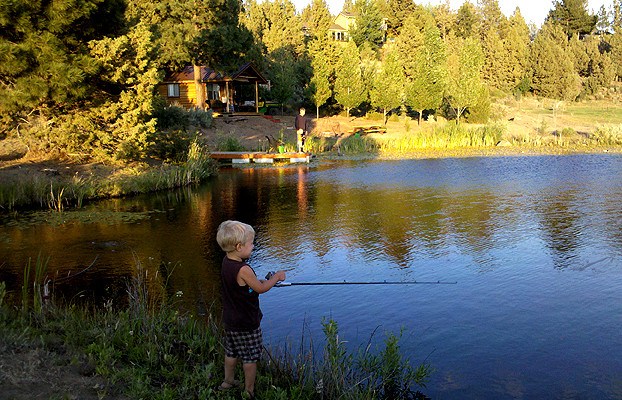Question: It's time to replace the PVC liner in my large pond, but I've read that I shouldn’t use PVC again. Could you please explain why I shouldn’t use PVC, and what I should be using? Answer: That's a great question, and one we’re asked frequently by homeowners, landscaping professionals and golf course pond designers. Polyvinyl Chloride (PVC) has been used in a variety of construction applications because it is cheap, easy to install and easy to replace. Although these factors give the impression that PVC would be ideal for many projects, PVC presents environmental and human health risks that outweigh its advantages. Here are a few of the many reasons that PVC is an unhealthy choice as a pond liner: 1) PVC has high chlorine and additives content, which makes it an environmental poison throughout its usage cycle. 2) PVC releases dioxin and other persistent organic pollutants during its manufacture and disposal. 3) PVC must have plasticizers added to achieve flexibility. These plasticizers are not bound to the polymer and can leach pollutants into water and air which presents further environmental and health risks. 4) PVC cannot be readily recycled. As a pond liner, PVC's characteristics make it far from ideal. Non-reinforced PVC is weak, has little to no UV resistance, and since it is glued together, has seams that are prone to leaking. Liners made with PVC are relatively heavy because they must be made thicker in order to achieve adequate strength. Seam failures, punctures and UV degradation are common problems that worsen as PVC liners age. BTL’s reinforced polyethylene liner, PPL-24, is specifically engineered to be fish and plant safe, offers superior UV resistance and is one of the most flexible and versatile reinforced liners available. PPL-24 has greater puncture and tear strength, is lighter weight, is available in larger factory panels and is less expensive than most of the competition. Unlike much weaker PVC and EPDM, the puncture resistant PPL-24 doesn't require a geotextile underlayment when placed over raked dirt, even if the surface has rounded rock in it. Polyethylene uses fewer problematic additives and has inherent chemical and hydrocarbon resistance. Polyethylene causes fewer problems after disposal, and reduces technical problems and costs during recycling. PPL-24 is available in a variety of sizes, and because of its lighter weight, single panels up to 60,000 square feet can be produced. These large panels mean that there are fewer seams, simplifying installation and reducing the risk of leaks and other problems. Both in environmental and functional concerns, a polyethylene liner is far superior to a PVC liner. Our PPL-24 reinforced polyethylene liner is the finest of its type, and will serve your pond needs for years to come. We look forward to working with you! Please call us today at 1-800-280-0712 for more information!
PVC Liners vs. PPL-24 Liners
AquaArmor Pond Liner
The most versatile liner on the market today, AquaArmor maximizes protection from harmful UV rays, tear resistance and punctures that cause leaks. Simply the best liner on the market.Newest Articles:
Subscribe to Updates
Article Topics
Agriculture
Covers
Tarps
Aquaponics
Energy
Liners
Hydroponics
Greenhouse Light Deprivation
Water Gardens
Farm Ponds
Greenhouses
Greenhouse Gardening
Greenhouse Cover
Fish Pond
Pond
Fish
Golf Course Pond
Golf Course Water Feature
Natural Pond
Landfill Cover
Irrigation
Irrigation Pond
Irrigation Canal
Hydraulic Fracturing
Oil Containment
Secondary Containment
Fracking
Oil Liner
Fuel Liner
Frac Pit
Fire Protection Pond
Fire Suppression Pond
Fire Pond
Geomembrane
Canal Liner
Brine Pond
Koi Pond
Algae Pond
Nursery Pond
Retention Pond
Man-Made Lake
Lakes
Geothermal Greenhouse
Commercial Greenhouse
Preformed Pond Liner
Groundwater Storage Lagoon
Mining Pond
Mining Lagoon
Evaporation Pond
Salt Pond
Pond Liner Materials
Catch Basin
Stormwater Management
Barren Pond
Processing Pond
Natural Swimming Pond
Drainage Systems
Ditch Lining
Aquaculture
Sewage Lagoon
Mining Geomembranes
Floating Cover
Wastewater Containment
Geosynthetics
Cistern Lining
Erosion Control
Fertilizer Containment
Winery Water
Silage Cover
Winery Irrigation Pond
Baseball Field Cover
Tailings Pond
Produced Water Liner
Produced Water Winery
Construction Pond
Winter Ponds
Fish Hatchery
Algae Raceways
Coal Ash Containment
Fishing Lakes
Oilfield Pits
Aquatic Habitats
Lake Restoration
Landfill Cell Liners and Cap Covers
Leachate Pond
Rain Cover
Heap Leach Pads
Residential Ponds
Gas Collection
California Drought
California Pond Liner
Overburden Containment
Pond Liner
Fish Stocking Pond
Mine Reclamation
Wastewater Cover
Drought
Irrigation Reservoir
Sludge Management
Cable Parks
Baffle Systems
Alternative Daily Covers
Reservoir Pond
Aeroponics
Food Shortages
Homesteading
Prepping
Toxic Waste
Potable Water Storage
Green Roof
Clearwells
Stormwater Harvesting
Snow Making Ponds
Pond Plants
Hunting Ponds
Oregon Pond Liner
Lavender
Site Runoff Containment
EPDM Liners
Duck Hunting Pond
Deer Hunting Pond
Decorative Ponds
Methane Capture
Large Pond
Sports Field Liner
California Fire Pond
Helicopter Dip Pond
Oregon Fire Pond
Pond Skimming
Geotextile Fabric
Silt Fences
Backyard Greenhouses
DIY Greenhouse
RPE Liners
Desalination
Controlled Environment Agriculture
Living Roofs
Dairy Lagoons
Tank Farm
Wastewater Treatment
Self-Sufficiency
Wicking Bed Liners
Hay Covers
Grow Bed Liner
Light Deprivation Greenhouses
Dam Lining
Frac Pad Liners
Geothermal Energy
Coal Mining




